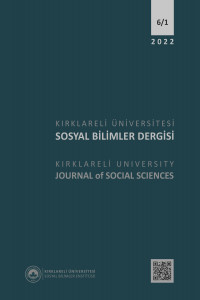Examination of the Relationship Between Cognitive Flexibility Skills and Teaching Motivations of Child Development Students
Araştırmanın amacı çocuk gelişimi öğrencilerinin bilişsel esneklik becerileri ile öğretme motivasyonları arasındaki ilişkiyi incelemektir. Araştırmada nicel araştırma deseni kullanılmış. Örneklem, eğitime devam eden 257 çocuk gelişimi öğrencisinden oluşmaktadır. Araştırmada, çocuk gelişimi öğrencilerine yönelik bilgileri içeren Kişisel Bilgi Formu, bilişsel esneklik düzeylerini belirlemek üzere Bilişsel Esneklik Envanteri ve öğretme motivasyon düzeylerini belirlemek üzere Öğretme Motivasyonu Ölçeği kullanılmıştır. Yapılan korelasyon analizi sonucunda çocuk gelişimi öğrencilerinin bilişsel esneklik becerileri ile öğrenme motivasyonları arasındaki pozitif yönden anlamlı bir ilişki olduğu ve çocuk gelişimi öğrencilerinin yaşı ile bilişsel esneklik becerileri ve iki alt boyutu olan alternatif ve kontrol boyutları ile arasında pozitif yönde düşük-orta derecede ilişki olduğu ortaya çıkmıştır. Ek olarak cinsiyete göre, bilişsel esnekliğin kontrol alt boyutunda kadın ve erkek arasında anlamlı bir farka rastlanmıştır. Çocuk gelişimi öğrencilerinin bilişsel esnekliklerinin ve bilişsel kontrol düzeylerinin annelerinin çalışıp çalışmama durumuna, kardeşler sırası, babaların mesleklerine göre, anlamlı bir şekilde farklılık olduğu ortaya çıkarılmıştır.
Examination of the Relationship Between Cognitive Flexibility Skills and Teaching Motivations of Child Development Students
The aim of this study is to examine the relationship between child development students' cognitive flexibility skills and their motivation to teach. A quantitative research design was used in the study. The sample consists of 257 child development students continuing their education. In the research, Personal Information Form containing information about child development students, Cognitive Flexibility Inventory (CFI) to determine cognitive flexibility levels, and Teaching Motivation Scale (TMS) to determine instructional motivation levels were used. As a result of the correlation analysis, it was revealed that there was a positive and significant relationship between the cognitive flexibility skills of child development students and their motivation for learning, and there was a low-to-moderate positive relationship between the ages of the children. child development students and cognitive flexibility skills, and alternative and control dimensions, which are two sub-dimensions. . In addition, a significant difference was found between men and women in the control sub-dimension of cognitive flexibility according to gender. It has been revealed that the cognitive flexibility and cognitive control levels of child development students differ significantly according to whether their mothers work or not, the order of their siblings, and their fathers' occupations. Key Words: Child
___
- İhtiyaroğlu, N. (2017). Yapısal ve Psikolojik Güçlendirmenin Öğretmen Motivasyonu Üzerindeki Etkisi. Kırıkkale Üniversitesi Sosyal Bilimler Dergisi, 7(2), 361-378.
- Martin, M.M., Anderson, C. M., & Thweatt, K. S. (1998). Aggressive Communication Traits And Their Relationship With The Cognitive Flexibility Scale And The Communication Flexibility Scale. Journal of Social Behavior and Personality, 13, (3), 34-45.
- Doğan Laçin, B. G., & Yalçın, İ. (2019). Üniversite öğrencilerinde öz-yeterlilik ve stresle başa çıkma stratejilerinin bilişsel esnekliği yordama düzeyleri. Hacettepe Üniversitesi Eğitim Fakültesi Dergisi, 34(2), 358-371.
